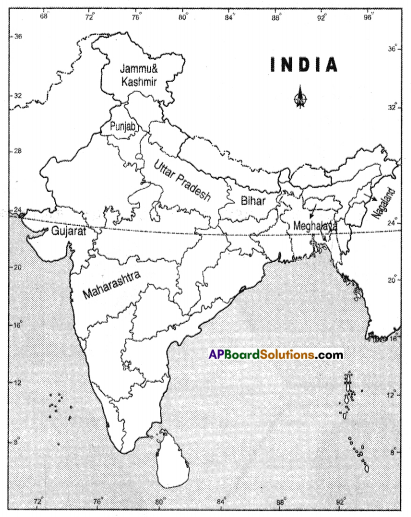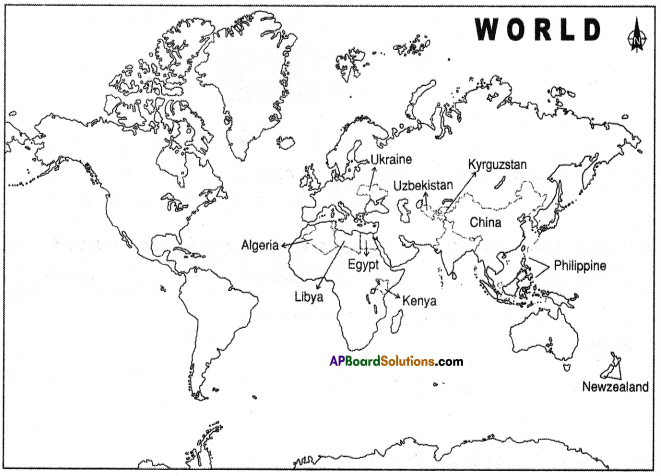SCERT AP 10th Class Social Study Material Pdf 3rd Lesson ఉత్పత్తి, ఉపాధి Textbook Questions and Answers.
AP State Syllabus 10th Class Social Solutions 3rd Lesson ఉత్పత్తి, ఉపాధి
10th Class Social Studies 3rd Lesson ఉత్పత్తి, ఉపాధి Textbook Questions and Answers
Improve your learning (మీ అభ్యసనాన్ని మెరుగుపడుచుకోండి)
ప్రశ్న 1.
బ్రాకెట్టులో ఇచ్చిన వాటి నుంచి సరైన వాటితో ఖాళీలు పూరించండి. (AS1)
i) ఉత్పత్తితో సమానంగా సేవారంగంలో ఉపాధి ……… (పెరిగింది / పెరగలేదు)
ii) ……………….. రంగంలోని కార్మికులు వస్తువులను ఉత్పత్తి చెయ్యరు. (సేవా / వ్యవసాయం)
iii) …………… రంగంలోని అధిక శాతం కార్మికులకు ఉద్యోగ భద్రత ఉంది. (వ్యవస్థీకృత / అవ్యవస్థీకృత)
iv) భారతదేశంలోని కార్మికులలో ………………. శాతం అవ్యవస్థీకృత రంగంలో పని చేస్తున్నారు. (ఎక్కువ / తక్కువ)
v) పత్తి …………………. ఉత్పత్తి, గుడ్డ ……………….. ఉత్పత్తి. (సహజ / పారిశ్రామిక)
జవాబు:
i) పెరగలేదు.
ii) సేవా
iii) వ్యవస్థీకృత
iv) ఎక్కువ
v) సహజ, పారిశ్రామిక
ప్రశ్న 2.
సరైన సమాధానాన్ని ఎంచుకోండి. (AS1)
అ) ఎక్కువగా సహజ ప్రక్రియలను ఉపయోగించుకుని ……………….. రంగంలో వస్తువులు ఉత్పత్తి చేస్తారు.
i) ప్రాథమిక
ii) ద్వితీయ
iii) తృతీయ
iv) సమాచార సాంకేతిక
జవాబు:
i) ప్రాథమిక
ఆ) స్థూల దేశీయోత్పత్తి అనేది ఒక సంవత్సరంలో ఉత్పత్తి చేసిన ……………. మొత్తం విలువ.
i) అన్ని వస్తువులు, సేవలు
ii) అన్ని అంతిమ వస్తువులు, సేవల
iii) అన్ని మాధ్యమిక వస్తువులు, సేవల
iv) అన్ని అంతిమ, మాధ్యమిక వస్తువులు, సేవల
జవాబు:
ii) అన్ని అంతిమ వస్తువులు, సేవల
ఇ) 2009-10 స్థూల దేశీయోత్పత్తిలో సేవా రంగం వాటా ………….
i) 20-30 శాతం మధ్య
ii) 30-40 శాతం మధ్య
iii) 50-60 శాతం మధ్య
iv) 70 శాతం
జవాబు:
iii) 50-60 శాతం మధ్య
![]()
ప్రశ్న 3.
వేరుగా ఉన్నదానిని గుర్తించండి, కారణం చెప్పండి. (AS1)
i) టీచరు, డాక్టరు, కూరగాయలు అమ్మే వ్యక్తి, న్యాయవాది.
ii) పోస్టుమాన్, చెప్పులుకుట్టే వ్యక్తి, సైనికుడు, పోలీసు కానిస్టేబులు.
జవాబు:
1) కూరగాయలు అమ్మే వ్యక్తి:
– మిగతా మూడు విద్యావంతులైన, నైపుణ్యం కల వృత్తులు చేస్తున్నవారు.
– వీరు సేవా రంగానికి చెందినవారు.
ii) చెప్పులు కుట్టే వ్యక్తి : ఇతను ప్రైవేటు రంగంలో పనిచేస్తున్నాడు.
ప్రశ్న 4.
ఆర్థిక కార్యకలాపాలను ప్రాథమిక, ద్వితీయ, తృతీయ రంగాలుగా విభజించటం ఉపయోగకరమేనా ఎందుకో వివరించండి. (AS1)
(లేదా)
ఆర్థిక కార్యకలాపాలను ప్రాథమిక, ద్వితీయ, తృతీయ రంగాలుగా విభజించటం ఉపయోగకరమేనా? ఏవేని రెండు ఉపయోగాలు తెల్పుము.
జవాబు:
- ఆర్థిక కార్యకలాపాలను ప్రాథమిక (వ్యవసాయ), ద్వితీయ (పరిశ్రమలు), తృతీయ (సేవా) రంగాలుగా విభజించడం ఉపయోగకరమే.
- జాతీయాదాయం, తలసరి ఆదాయం మొదలగునటువంటివి గణించటానికి సులభంగా ఉంటుంది.
- ఏ రంగంలో ఎంత ఉత్పత్తి, ఉపాధి జరిగిందో తెలుసుకోవచ్చు. దానికనుగుణంగా అభివృద్ధి ప్రణాళికలను రూపొందించవచ్చును.
- సౌకర్యాల ఏర్పాటుకు, అభివృద్ధి చర్యలు చేపట్టుటకు ఇది ఉపయోగపడుతుంది.
- ఆదాయ, సంపద పంపిణీల్లో అసమానతలను తెలుసుకోవచ్చు. వాటిని రూపుమాపడానికి తగిన చర్యలు తీసుకోవచ్చు.
- జాతీయ ఉత్పత్తిలోని ఈ అంశాలు ఆర్థిక వ్యవస్థ నిర్మాణాన్ని తెలియచేస్తుంది. దేశంలోని ఆర్ధిక స్థితిగతులను తెలుసుకోవచ్చు.
- జాతీయ విధానాల రూపకల్పనకు, ప్రజల జీవన ప్రమాణస్థాయి తెలుసుకొనుటకు, మెరుగుపర్చుటకు.
ప్రశ్న 5.
ఈ అధ్యాయంలో మనం చూసిన ప్రతి రంగంలో స్థూల జాతీయోత్పత్తిలోనూ, ఉపాధిలోనూ దృష్టి ఎందుకు కేంద్రీకరించాలి? ఇంకా పరిశీలించాల్సిన ఇతర అంశాలు ఏమైనా ఉన్నాయా? చర్చించండి. (AS4)
జవాబు:
- ఆర్థిక వ్యవస్థ (దేశం) అభివృద్ధి పథంలో ఉందో లేదో తెలుసుకొనుటకుగాను స్థూల జాతీయోత్పత్తిలోనూ, ఉపాధిలోనూ దృష్టి కేంద్రీకరించాలి. ఇంకా
- ప్రజల యొక్క జీవన ప్రమాణ స్థాయి తెలుసుకొనుటకు, అభివృద్ధిపరచుటకు
- అభివృద్ధి ప్రణాళికలను వ్యూహాలను రూపొందించుటకు, ప్రణాళికల్లో ఏ రంగానికి ప్రాధాన్యతనివ్వాలో నిర్ణయించుటకు.
- పేదరికం, నిరుద్యోగ స్థాయిలు తెలుసుకొనుటకు, వాటిని రూపుమాపుటకు.
- సమన్యాయ పంపిణీ కోసం (జాతీయాదాయం), సమతౌల్య అభివృద్ధి సాధించుటకు,
- అన్ని రంగాలలో స్వయం సమృద్ధి సాధించుటకు ; ఉత్పత్తి, ఉపాధిపై దృష్టి పెట్టాలి.
ఇతర అంశాలు:
- సాంకేతిక, వైజ్ఞానిక నైపుణ్యం
- ఆధునిక సమాచార, ప్రసార అభివృద్ధి
- ఎగుమతులు, దిగుమతులు
- ప్రాంతీయాభివృద్ధి
- విద్య, వైద్యం, విద్యుత్, రవాణా, త్రాగునీరు, సాగునీరు మొదలయిన అవస్థాపన సౌకర్యాలు.
![]()
ప్రశ్న 6.
సేవా రంగం ఇతర రంగాలకంటే ఎలా భిన్నమైనది? కొన్ని ఉదాహరణలతో వివరించండి. (AS1)
జవాబు:
సేవా రంగం ఇతర రెండు రంగాల కంటే భిన్నమైనది.
- దేశ సామాజిక, ఆర్థికాభివృద్ధికి సేవల రంగం ప్రాణవాయువులాంటిది.
- ఒక ఆర్థిక వ్యవస్థకు ప్రాథమిక, ద్వితీయ రంగాలు పుష్టినిస్తే, సేవల రంగం ఆధునికీకరణ చేస్తుంది.
- ఇతర రంగాలలాగా నేరుగా వస్తువులను తయారుచేయకుండా వస్తువుల ఉత్పత్తికి, ప్రజలకు అవసరమైన సేవలు మాత్రమే ఈ రంగం అందిస్తుంది.
ఉదా : వస్తువులు, ప్రయాణీకులను రవాణా చేయటం. - సేవారంగం ఇతర రంగాల అభివృద్ధికి పరిపూరక రంగంగా పనిచేస్తూ ఉంటుంది.
ఉదా : ఉత్పత్తి పెరుగుదలకు అవసరమైన అవస్థాపనా సౌకర్యాలను సేవా రంగం అందిస్తుంది. - వ్యవసాయ రంగం అభివృద్ధి చెందాలంటే సాగునీరు, విద్యుత్తు, పరపతి, రవాణా సౌకర్యాలు, రసాయనిక ఎరువులు మొదలయిన సేవలు అవసరం.
- పరిశ్రమల రంగం అభివృద్ధి చెందాలంటే యంత్ర పరికరాలు, విద్యుత్ (శక్తి వనరులు), బీమా సౌకర్యాలు, రవాణా, మార్కెట్ సౌకర్యాలు, బ్యాంకులు మొదలయిన సేవలు అవసరం.
- మిగతా రెండు రంగాల కంటే ఈ రంగం విశ్వవ్యాప్తంగా అతి పెద్ద రంగంగా అభివృద్ధి చెందుతుంది.
- మిగతా రెండు రంగాల కంటే ఈ రంగం ఎక్కువ భాగం ఉపాధిని, ఉత్పత్తిని కలిగిస్తోంది.
ప్రశ్న 7.
అల్ప ఉపాధి అంటే ఏమి అర్థం చేసుకున్నారు ? పట్టణ, గ్రామీణ ప్రాంతాల నుంచి ఒక్కొక్క ఉదాహరణతో వివరించండి. (AS1)
జవాబు:
- ఎవరికీ తమ పూర్తి సామర్థ్యానికి తగినట్లుగా మరియు తగినంతగా పని దొరకని స్థితిని అల్ప ఉపాధి అనవచ్చును. తక్కువ ఉత్పాదకత గల వ్యవసాయ, సేవల రంగంలో పనిచేస్తున్న శ్రామికులను “అల్ప ఉద్యోగులు” అంటారు. కనపడని ఈ రకమైన అల్ప ఉపాధినే “ప్రచ్ఛన్న నిరుద్యోగం” అంటారు.
- సిరిపురం గ్రామంలోని సాంబయ్య అనే రైతుకు 5 ఎకరాల వర్షాధార భూమి ఉంది. మిరప, ప్రత్తి, మొక్కజొన్న వంటి పంటలు పండిస్తాడు. కుటుంబంలోని ‘6’ గురు సభ్యులు సంవత్సరమంతా అందులోనే పనిచేస్తారు. కారణం వాళ్ళకు చెయ్యటానికి వేరే పనిలేదు. వారి శ్రమ విభజింపబడుతోంది. అందరూ ఏదో ఒక పని చేస్తున్నారు కానీ ఎవరికీ పూర్తి పని లేదు. ఈ కుటుంబంలోని ఇద్దరి ముగ్గురు వేరే పనికి వెళ్ళిన ఉత్పత్తి తగ్గదు.
- పట్టణ ప్రాంతంలో సేవా రంగంలో రోజుకూలీ కోసం వెతుక్కునేవాళ్లు వేలాదిగా ఉన్నారు. రంగులు వేయటం, నీటి పైపుల పని, మరమ్మతులు చేయటం వంటి పనులు చేస్తారు. వీళ్లల్లో చాలామందికి ప్రతిరోజూ పని దొరకదు.
ప్రశ్న 8.
అవ్యవస్థీకృత రంగంలోని కార్మికులకు ఈ కింది అంశాలలో రక్షణ కావాలి. (AS1)
కూలీ, భద్రత, వైద్యం : ఉదాహరణలతో వివరించండి. –
జవాబు:
అవ్యవస్థీకృతరంగంలో చిన్నచిన్న సంస్థలు అక్కడక్కడా ఉంటాయి. ఇవి సాధారణంగా ప్రభుత్వ నియంత్రణలో ఉండవు. నియమ నిబంధనలు ఉంటాయి కానీ వాటిని అనుసరించరు. స్వయం ఉపాధి పొందే చిన్నచిన్న (మరమ్మతులు) పనులు చేసేవారు కూడా కష్టంగానే జీవితం వెల్లబుచ్చాల్సి వస్తుంది. అందుకని అవ్యవస్థీకృత రంగంలోని కార్మికులకు కూలీ, భద్రత, వైద్యం మొదలగు వాటిల్లో రక్షణ కల్పించాలి.
1) కూలి :
అవ్యవస్థీకృత రంగంలోని కార్మికులకు జీతం తక్కువగా ఉంటుంది, పని ఎక్కువ, వేతనం తక్కువ, ఆర్జిత సెలవు, సెలవులు, అనారోగ్యమప్పుడు సెలవులు వంటివి ఉండవు. వ్యవసాయ కూలీలు భవన నిర్మాణ కూలీలు అధికశాతం మంది చాలా తక్కువ వేతనానికి పనిచేస్తున్నారు. వీళ్లు తరచు దోపిడికి గురవుతుంటారు, వీళ్లకు న్యాయమైన – వేతనం చెల్లించబడదు. సంపాదన తక్కువ అది క్రమం తప్పకుండా ఉండదు.
ఈ రంగంలోని కార్మికుల జీవన ప్రమాణాలు మెరుగు పడాలంటే, వీరి యొక్క కొనుగోలు శక్తి పెరగాలన్నా, ఆర్థిక, సామాజిక అభివృద్ధి పొందాలన్నా వీరికి రక్షణ, మద్దతు అవసరం.
2) భద్రత :
అవ్యవస్థీకృత రంగంలోని కార్మికులకు ఉద్యోగ భద్రత ఉండదు, అలాగే జీవితానికి భద్రత ఉండదు. ఏ కారణం లేకుండా ఉద్యోగస్తులను మానుకోమనవచ్చు. పని తక్కువగా ఉండే కాలాల్లో కొంతమందిని పని మానిపించవచ్చు. మారుతున్న మార్కెటు పరిస్థితి, ఉపాధి కల్పిస్తున్న వాళ్ల మానసిక స్థాయిపై ఆధారపడి ఉంటుంది. మరింత పని అవసరంతో పాటు అవ్యవస్థీకృత రంగంలోని కార్మికులకు రక్షణ, మద్దతు అవసరం.
3) వైద్యం :
అవ్యవస్థీకృత రంగంలోని కార్మికులకు వైద్య ప్రయోజనాలు అందవు, అనారోగ్యమప్పుడు సెలవులు వంటివి కూడా ఉండవు. అనారోగ్యం పాలైతే వారి కుటుంబ జీవనం దుర్భరంగా మారుతుంది. కనుక ఖచ్చితంగా వీరికి జీవితబీమా, ఆరోగ్యబీమా మొదలయినటువంటి సౌకర్యాలు కల్పించాలి. అప్పుడే వారి కుటుంబాలకు, వారికి రక్షణ ఉంటుంది.
![]()
ప్రశ్న 9.
అహ్మదాబాదు నగరంలో జరిపిన అధ్యయనంలో 15 లక్షలమంది కార్మికులు ఉండగా అందులో 11 లక్షలమంది అవ్యవస్థీకృత రంగంలో పని చేస్తున్నారని తెలిసింది. ఆ సంవత్సరం (1997-98)లో నగరం మొత్తం ఆదాయం 6000 కోట్ల రూపాయలు. అందులో వ్యవస్థీకృత రంగం వాటా 3200 కోట్ల రూపాయలు. ఈ గణాంకాలను ఒక పట్టిక రూపంలో ఇవ్వండి. పట్టణంలో మరింత ఉపాధి కల్పించే మార్గాలు ఏమిటి?
జవాబు:
అహ్మదాబాదు నగరంలో వ్యవస్థీకృత, అవ్యవస్థీకృత రంగాల వాటాలు (1997-98) :
| రంగం | ఉద్యోగస్తులు | ఆదాయం (కోట్లలో) |
| వ్యవస్థీకృత | 4,00,000 | ₹ 3200/- |
| అవ్యవస్థీకృత | 11,00,000 | ₹2800/- |
| మొత్తం | 15,00,000 | ₹ 6000/- |
పట్టణంలో మరింత ఉపాధి కల్పించే మార్గాలు :
- ప్రభుత్వం వివిధ పథకాలను, ప్రణాళికలను రూపొందించి అమలుచేయడం.
ఉదా : TRVSEM, SHG లు - స్వయం ఉపాధి పొందేవారికి ఆర్థిక మరియు ఇతరత్ర సహాయమందించడం.
ఉదా : పన్నుల మినహాయింపు - చిన్న, మధ్యతరహా పరిశ్రమలకు ప్రోత్సాహమందించాలి.
ఉదా : సులభ లైసెన్సింగ్ విధానం, పరపతి సౌకర్యం కల్పించటం. - విద్యావిధానం, మానవ వనరులను అభివృద్ధిపర్చే విధంగా ఉండాలి.
ఉదా : వృత్తి విద్యా కళాశాలల ఏర్పాటు. - అవ్యవస్థీకృత రంగంలోని కార్మికులకు రక్షణ, మద్దతు కల్పించాలి.
ఉదా : కనీస వేతనాల చట్టం అమలుచేయటం.
ప్రశ్న 10.
మన రాష్ట్రంలో వివిధ ప్రదేశాలలో వ్యవస్థీకృత, అవ్యవస్థీకృత రంగాలలో ఉపాధి అవకాశాల గురించి క్రింది పట్టికలో రాయండి. (AS3)
| ప్రాంతం | వ్యవస్థీకృత ఉపాధి అవకాశాలు | అవ్యవస్థీకృత ఉపాధి అవకాశాలు |
| 1. ఉత్తరాంధ్ర | ||
| 2. దక్షిణ కోస్తా | ||
| 3. రాయలసీమ |
జవాబు:
| ప్రాంతం | వ్యవస్థీకృత ఉపాధి అవకాశాలు | అవ్యవస్థీకృత ఉపాధి అవకాశాలు |
| 1. ఉత్తరాంధ్ర | 1. ప్రభుత్వ రంగంలో రవాణా, వైద్యం విద్య ఆరోగ్యం మొదలైనవి. 2. ప్రైవేటు రంగంలో |
1. వ్యవసాయ రంగం 2. మత్స్య పరిశ్రమ 3. చేతి వృత్తులు 4. పారిశ్రామిక రంగం |
| 2. దక్షిణ కోస్తా | 1. ప్రభుత్వ రంగంలో 2. ప్రైవేటు రంగంలో |
1. వ్యవసాయ రంగం 2. మత్స్య పరిశ్రమ 3. చేతి వృత్తులు 4. పారిశ్రామిక రంగం 5. నిర్మాణ రంగం |
| 3. రాయలసీమ | 1. ప్రభుత్వ రంగంలో 2. ప్రైవేటు రంగంలో |
1. వ్యవసాయ రంగం 2. చేతి వృత్తులు |
10th Class Social Studies 3rd Lesson ఉత్పత్తి, ఉపాధి InText Questions and Answers
10th Class Social Textbook Page No.28
ప్రశ్న 1.
దిగువ తెలిపిన వివిధ వృత్తుల వారిని వ్యవసాయం, పరిశ్రమ, సేవా రంగాల కింద వర్గీకరించండి. మీ వర్గీకరణకు కారణాలు ఇవ్వండి.
| వృత్తి | వర్గీకరణ |
| బట్టలు కుట్టేవారు | |
| బుట్టలు అల్లేవారు | |
| పూల సాగు చేసేవారు | |
| పాలు అమ్మేవారు | |
| చేపలు పట్టేవారు | |
| మత బోధకులు / పూజారులు | |
| ఉత్తరాలు బట్వాడా చేసే కొరియర్ | |
| అగ్గిపెట్టెల కర్మాగారంలో పనిచేసేవారు | |
| వడ్డీ వ్యాపారి | |
| తోటమాలి | |
| కుండలు చేసేవారు | |
| తేనెటీగలను పెంచేవారు | |
| వ్యోమగామి | |
| కాల్ సెంటర్ ఉద్యోగులు |
జవాబు:
| వృత్తి | వర్గీకరణ |
| బట్టలు కుట్టేవారు | సేవా రంగం |
| బుట్టలు అల్లేవారు | పరిశ్రమల రంగం (కుటీర పరిశ్రమ) |
| పూల సాగు చేసేవారు | వ్యవసాయ రంగం |
| పాలు అమ్మేవారు | వ్యవసాయ రంగం |
| చేపలు పట్టేవారు | వ్యవసాయ రంగం |
| మత బోధకులు / పూజారులు | సేవా రంగం |
| ఉత్తరాలు బట్వాడా చేసే కొరియర్ | సేవా రంగం |
| అగ్గిపెట్టెల కర్మాగారంలో పనిచేసేవారు | పరిశ్రమల రంగం |
| వడ్డీ వ్యాపారి | సేవా రంగం |
| తోటమాలి | వ్యవసాయ రంగం |
| కుండలు చేసేవారు | పరిశ్రమల రంగం (కుటీర పరిశ్రమ) |
| తేనెటీగలను పెంచేవారు | వ్యవసాయ రంగం |
| వ్యోమగామి | సేవా రంగం |
| కాల్ సెంటర్ ఉద్యోగులు | సేవా రంగం |
![]()
10th Class Social Textbook Page No.29
ప్రశ్న 2.
కింది పట్టిక భారతదేశంలో 1972-73 లోనూ, తిరిగి 2009-10 అంటే 37 ఏళ్ల తర్వాత ఏ రంగంలో ఎంతమంది ఉపాధి పొందుతున్నారో తెలియచేస్తుంది.

(అ) పై పట్టిక ద్వారా మీరు గమనించిన ప్రధాన మార్పులు ఏమిటి?
జవాబు:
1972-73 నుండి 2009-10 సం||ల మధ్య (దాదాపు 37 సం||లు) ఉపాధిలో వచ్చిన మార్పులు
- వ్యవసాయ రంగంలో ఉపాధి పొందుతున్నవారి శాతం 21% తగ్గింది.
- పరిశ్రమ రంగంలో ఉపాధి పొందుతున్నవారి శాతం 11% పెరిగింది.
- సేవల రంగంలో ఉపాధి పొందుతున్నవారి శాతం 10% పెరిగింది.
- ప్రాథమిక రంగం (వ్యవసాయ రంగం) లో ఉపాధి శాతం తగ్గటం, ద్వితీయ (పరిశ్రమ) తృతీయ (సేవల) రంగాలు అభివృద్ధి చెందటం ఆర్థికాభివృద్ధి సూచికగా చెప్పవచ్చు.
ఆ) ఇంతకుముందు మీరు చదివిన దాని ఆధారంగా ఈ మార్పులకు కారణాలు ఏమిటో చర్చించండి.
జవాబు:
ఈ మార్పులకు కారణాలు :
- పారిశ్రామిక విప్లవం ద్వారా పరిశ్రమ అభివృద్ధి చెందడం వలన ఆ రంగంలో ఉపాధి పెరిగింది.
- ఉత్పత్తి పెరగడం, మార్కెట్స్ పెరగడం, వ్యాపారం, వాణిజ్యం పెరగడం (రవాణా పెరగడం) వలన సేవారంగంలో ఉపాధి పెరిగింది.
- ప్రభుత్వ విధానాలు (1991 పారిశ్రామిక విధానం, గ్లోబలైజేషన్ మొదలగునవి) ప్రణాళికలు కూడా ఈ మార్పుకు దోహదం చేశాయి.
- పెరుగుతున్న వైజ్ఞానిక, సాంకేతిక సమాచార వ్యవస్థ సేవారంగంలో ఎంతోమందికి ఉపాధి కల్పిస్తుంది.
10th Class Social Textbook Page No.29
ప్రశ్న 3.
ఈ దిగువ చిత్రాలను పరిశీలించి అవి ఏ రంగాలకు చెందినవో పేర్కొనండి.

జవాబు:
- వ్యవసాయ రంగం
- (గనులు) ప్రాథమిక రంగం
- సేవల రంగం
- పారిశ్రామిక రంగం
10th Class Social Textbook Page No.30
ప్రశ్న 4.
ఈ కింది గ్రాఫ్ రెండు వేరు వేరు సంవత్సరాలు, 1972-73, 2009-10 లకు భారతదేశ స్థూల దేశీయోత్పత్తి విలువను చూపిస్తుంది. సంవత్సరాలలో మొత్తం ఉత్పత్తి పెరిగిన తీరును మీరు చూడవచ్చు.
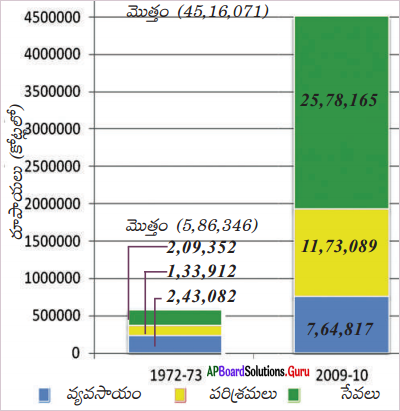
గ్రాఫ్ : వ్యవసాయం, పరిశ్రమలు, సేవా రంగాల వారీగా స్థూల దేశీయోత్పత్తి
గ్రాఫ్ ను చూసి కింది ప్రశ్నలకు జవాబులివ్వండి :
(1) 1972-78లో అధిక ఉత్పత్తి ఉన్న రంగం ఏది?
జవాబు:
1972-73లో వ్యవసాయం రంగం అధిక ఉత్పత్తి కలిగి ఉన్నది. మొత్తం GDP 5,86,346 కోట్లలో వ్యవసాయరంగం 2,43,082 కోట్లు కలిగి ఉంది.
(2) 2009-10 లో అధిక ఉత్పత్తి ఉన్న రంగం ఏది?
జవాబు:
2009-10 లో సేవా రంగం అధిక ఉత్పత్తి కలిగి ఉన్నది. మొత్తం GDP 45,16,071 కోటలో సేవా రంగం 26,78,165 కోట్లు మిగిలిన వ్యవసాయ రంగం 7,64,817 కోట్లు మరియు పరిశ్రమల రంగం 11,73,089 కోట్లు వాటా కలిగి ఉన్నాయి.
(3) 1972-73, 2009-10 సంవత్సరాల మధ్య భారతదేశంలో మొత్తం వస్తువులు, సేవల ఉత్పత్తి సుమారుగా …….. రెట్లు పెరిగింది.
జవాబు:
8 రెట్లు పెరిగింది.
10th Class Social Textbook Page No.31
ప్రశ్న 5.
ప్రతి దశలో మొత్తం వస్తువుల విలువ :
మొదటి దశ (రైస్ మిల్లర్కు రైతు వడ్లు అమ్మడం) రూ. 2500
రెండవ దశ (మాటలు యజమానికి ఊక, బియ్యం అమ్మడం) రూ. 3600
మూడవ దశ (ఇడ్లీ, దోశలు అమ్మడం) రూ. 5000
– చర్చించండి : ఉత్పత్తి అయిన మొత్తం వస్తువుల విలువను తెలుసుకోటానికి వీటన్నిటి మొత్తాన్ని జోడించాలా?
జవాబు:
అవసరం లేదు. ఉత్పత్తి అయిన మొత్తం వస్తువుల విలువను తెలుసుకోటానికి వీటన్నిటి మొత్తాన్ని జోడించనవసరం లేదు.
- అంతిమ వస్తు ధరలో (విలువలో) ఆ వస్తువు తయారీలో వాడిన మాధ్యమిక వస్తువుల విలువ కలిసి ఉంటుంది.
- అలా కనక జోడిస్తే ఆ వస్తువు ధరను రెండుసార్లు లెక్కించినట్లవుతుంది.
- పై ఉదాహరణలో వడ్లు, బియ్యం, ఊక అనేవి మాధ్యమిక వస్తువులు, ఇడ్లీ, దోశ అనేవి అంత్య వస్తువులు.
- ప్రతి దశలో ఉత్పత్తిదారులు ఉత్పాదకాలు తయారుచేసినవారికి మొత్తం విలువ చెల్లించారు.
![]()
10th Class Social Textbook Page No.31
ప్రశ్న 6.
పై ఉదాహరణలో వడ్లు, బియ్యం మధ్య దశలోని ఉత్పాదకాలు కాగా, ఇడ్లీ, దోశ వంటివి తుది ఉత్పాదకాలు. మనం నిత్యజీవితంలో ఉపయోగించే కొన్ని వస్తువులను దిగువ సూచించడమైనది. వాటికి ఎదురుగా ఆయా వస్తువుల మధ్య దశ ఉత్పాదకాలను రాయండి.
| తుది ఉత్పాదకాలు | మధ్యదశ ఉత్పాదకాలు |
| నోటు పుస్తకం | |
| కారు | |
| కంప్యూటర్ |
జవాబు:
| తుది ఉత్పాదకాలు | మధ్యదశ ఉత్పాదకాలు |
| నోటు పుస్తకం | కాగితపు గుజ్జు, కాగితం, కార్డ్ బోర్డు, బంక, పిన్నులు |
| కారు | టైర్లు, లైట్స్, మెటల్ షీట్స్, రంగులు, సీట్లు, పెట్రోలు/డీసెల్ |
| కంప్యూటర్ | సిలికాన్ చిప్స్, మానిటర్, కేబుల్స్, సాఫ్ట్ వేర్స్, సర్క్యుట్స్ |
10th Class Social Textbook Page No.32
ప్రశ్న 7.
మొదటి దశ (రైస్ మిల్లర్ కు రైతు వడ్లు అమ్మటం) = రూ. 2500 లోంచి కొనుగోలు చేసిన ఉత్పాదకాల విలువ ‘0’ రూపాయలు తీసేస్తే, జోడించిన విలువ 2500 రూపాయలు
రెండవ దశ (మాటలు యజమానికి ఊక, బియ్యం అమ్మటం) = రూ. 3600 లోంచి కొనుగోలు చేసిన ఉత్పాదకాల విలువ 2500 తీసేస్తే, జోడించిన విలువ 1100 రూపాయలు
మూడవ దశ (ఇడ్లీ, దోశల అమ్మకం) = రూ. 5000 లోంచి కొనుగోలు చేసిన విలువ 3600 తీసేస్తే, జోడించిన విలువ 1400 రూపాయలు.
ప్రతి దశలోనూ జోడించిన విలువ = 2500+ 1100 + 1400 = 5000
చర్చించండి : రెండు పద్ధతులలోనూ ఒకే సమాధానం ఎందుకు వచ్చింది?
జవాబు:
- ప్రతి దశలోనూ జోడించిన విలువ = (2500 + 1100 + 1400) = 5000
- అంతిమ వస్తువు ధర (దోశ ధర) = 5000. రెండు పద్ధతుల్లోను ఒకే సమాధానం వచ్చింది. కారణం
- జోడించిన విలువలు మాత్రమే లెక్కించడం వలన (మాధ్యమిక వస్తువులు జోడించిన విలువ)
- మొదటి పద్ధతిలో అంత్య వస్తువు (ఇడ్లీ) లోనే ఇవి అన్నీ ఇమిడి ఉంటాయి.
- రెండు పద్ధతుల్లో అంతిమ వస్తువుల విలువ ఒక్కటే కాబట్టి,
- రెండు పద్ధతుల్లోనూ ఒకే సమాధానం వచ్చింది.
![]()
10th Class Social Textbook Page No.32
ప్రశ్న 8.
కింది పట్టికలో స్థూల జాతీయోత్పత్తి విలువ ఇవ్వబడింది. 2010-2011 సంవత్సరానికి లెక్కించిన విధంగా స్థూల దేశీయోత్పత్తి పెరుగుదల రేటును మిగతా సంవత్సరాలకు గణించండి.

జవాబు:
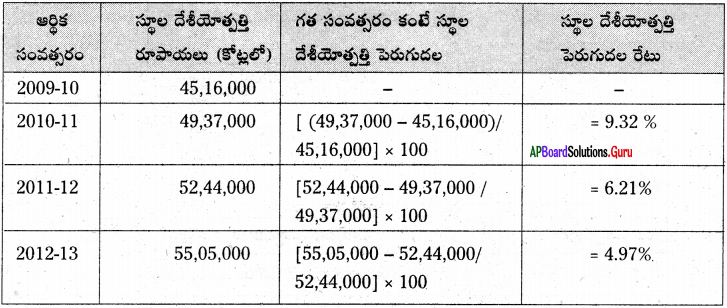
10th Class Social Textbook Page No.34
ప్రశ్న 9.
వ్యాపారం, టళ్లు, రవాణా, ప్రసారాలకు కొన్ని ఉదాహరణలు పేర్కొనండి.
జవాబు:
- వివిధ రకాల వస్తువులు అమ్మే అన్నీ రకాల దుకాణాలు, ఎగుమతులు దిగుమతులు, సూపర్ మార్కెట్లు, మాల్స్
- చిన్న హెూటళ్ల నుండి స్టార్ హోటళ్లు దాకా.
- రోడ్డు, రైల్వే, విమానయాన, ఓడల ద్వారా రవాణా ఈ కోవ కిందకి వస్తాయి.
- రేడియో, టి.వి., వార్తాపత్రికలు, వివిధ మాస వార పత్రికలు, ఇంటర్నెట్ సౌకర్యం, టెలికమ్యూనికేషన్స్ (టెలిఫోన్, సెల్ ఫోన్) ఉపగ్రహ సాంకేతికత మొదలగునవి.
10th Class Social Textbook Page No.35
ప్రశ్న 10.
పట్టిక : భారతదేశంలో పరిశ్రమలవారీగా కార్మికుల వివరాలు, 2009-2010 (%)

పట్టికని జాగ్రత్తగా అధ్యయనం చేసి కింది ప్రశ్నలకు సమాధానాలు ఇవ్వండి.
1) వ్యవసాయ రంగంలోని అత్యధిక మంది కార్మికులు ………………………… లో నివసిస్తున్నారు.
2) చాలామంది ………………………. పనివారు వ్యవసాయ రంగంలో ఉపాధి పొందుతున్నారు.
3) 90% కంటే అధికంగా పట్టణ ప్రాంత పనివారు ……………., ……………… రంగాలలో ఉపాధి పొందుతున్నారు.
4) స్త్రీ, పురుషుల నిష్పత్తి పోలిస్తే స్త్రీలు ………………., ………………….. రంగాలలో కొద్ది శాతం మాత్రమే ఉపాధి పొందుతున్నారు.
జవాబు:
1) గ్రామప్రాంతం
2) మహిళ (స్త్రీ)
3) పారిశ్రామిక, సేవా
4) పారిశ్రామిక, సేవా
10th Class Social Textbook Page No.36 & 37
ప్రశ్న 11.
‘పై’ చార్టు : మూడు రంగాలలో ఉపాధి వాటా
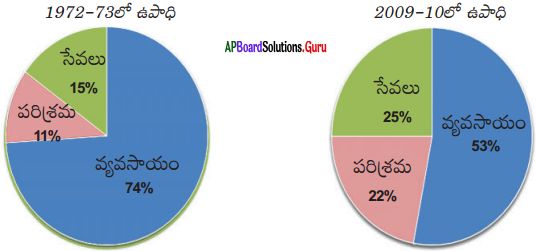
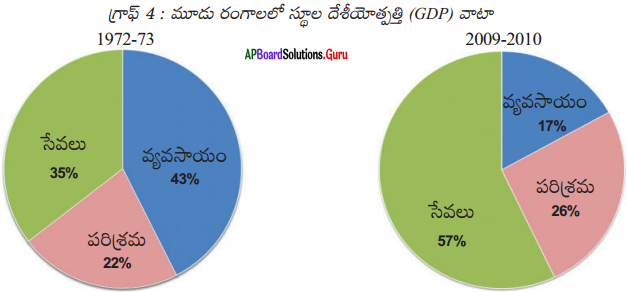

జవాబు:

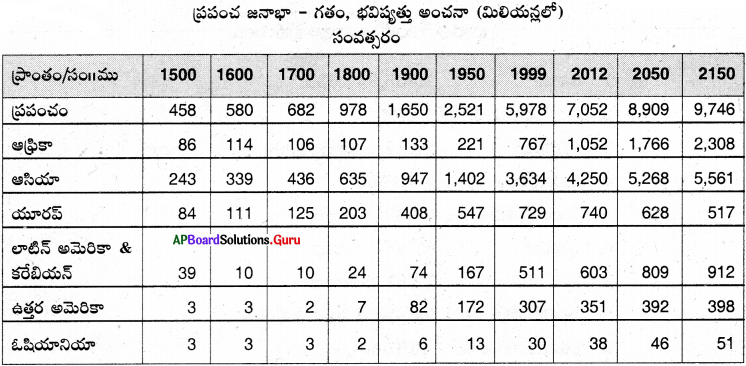
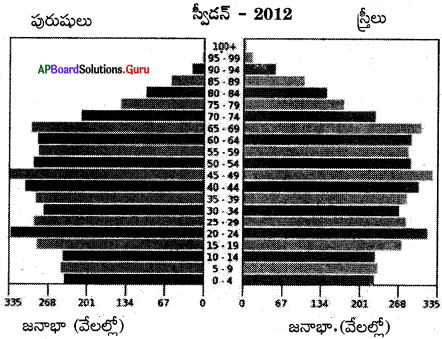
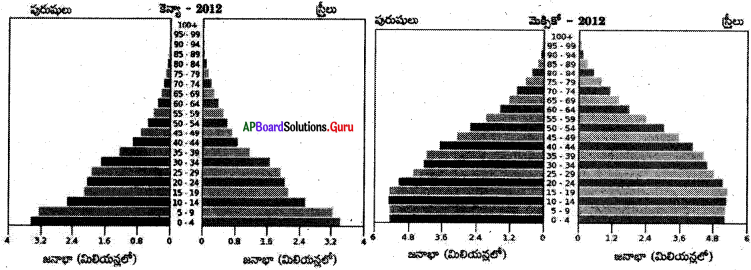
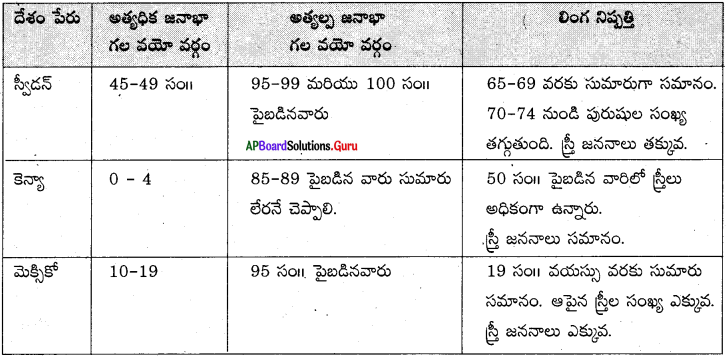
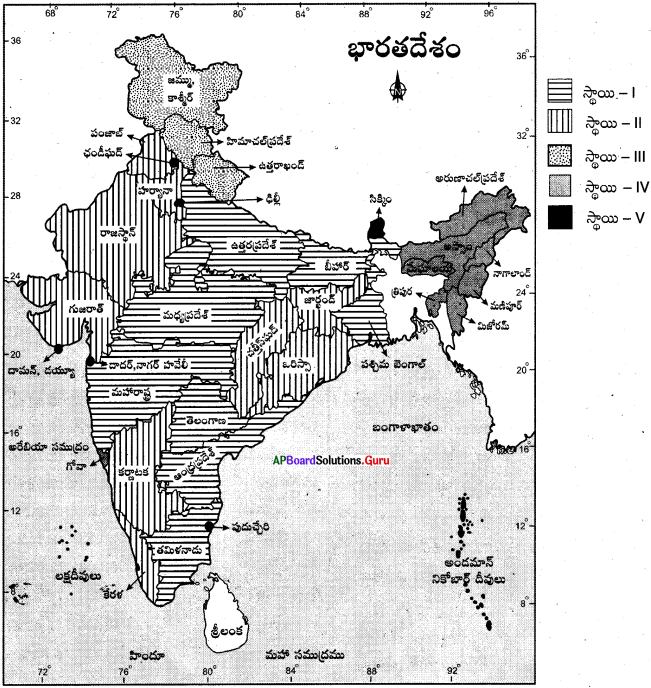
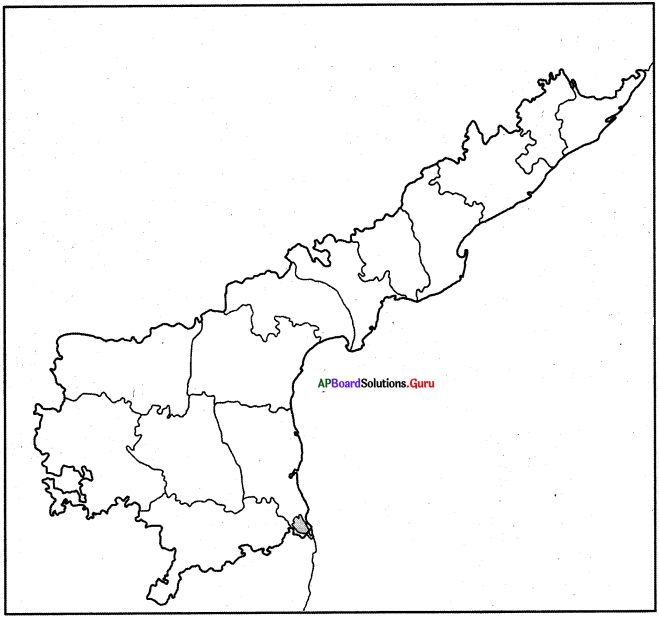


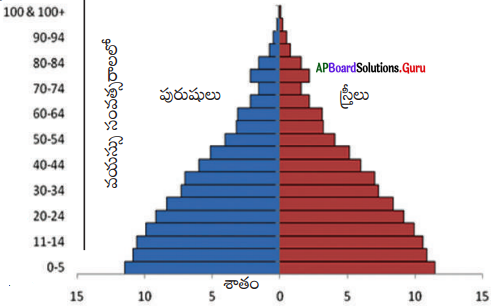
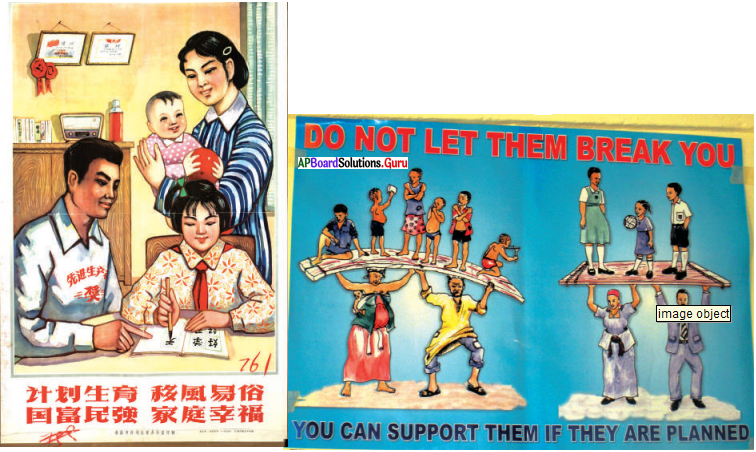
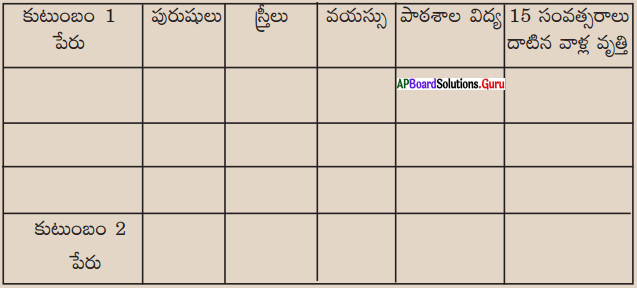
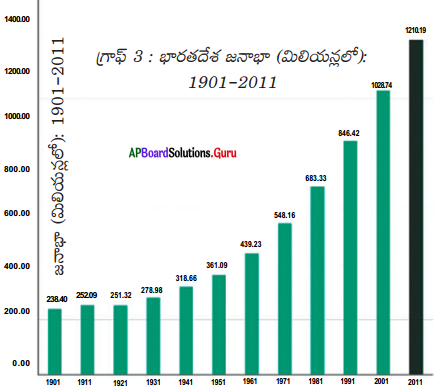
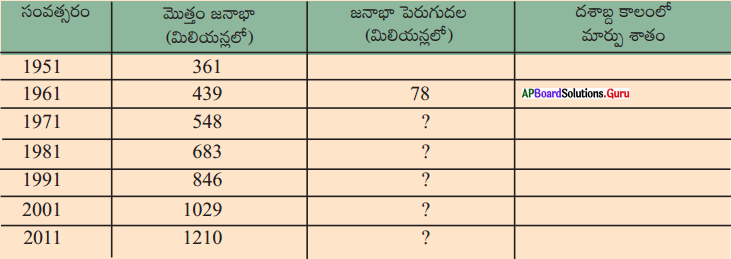
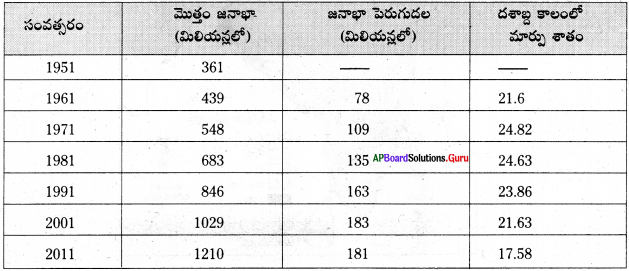
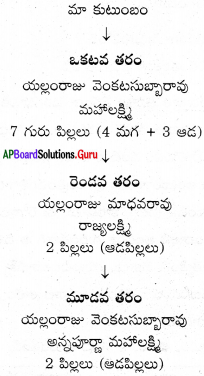
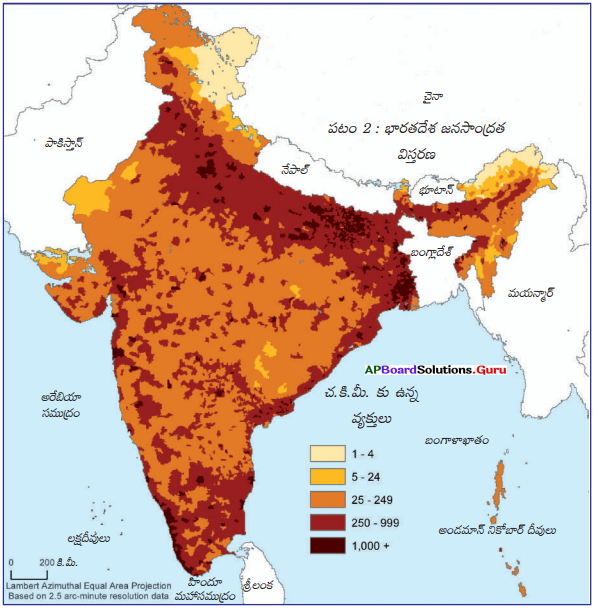
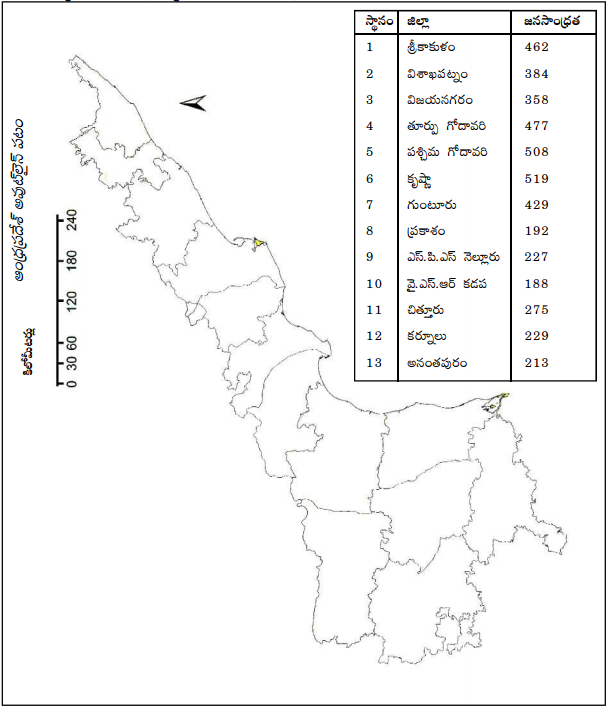

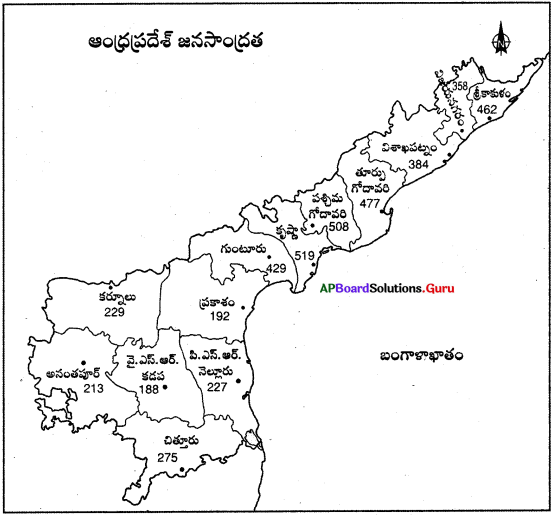
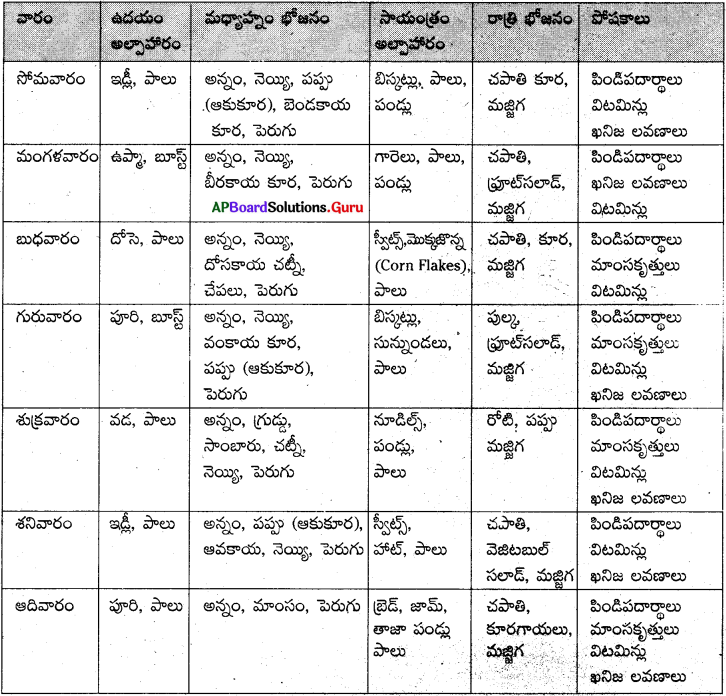
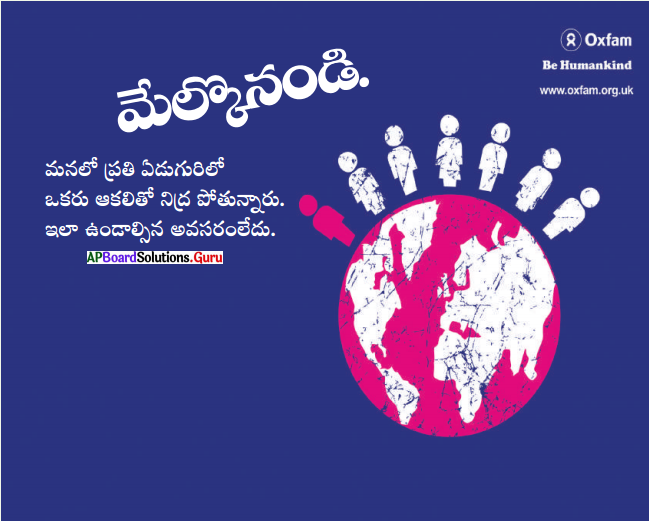

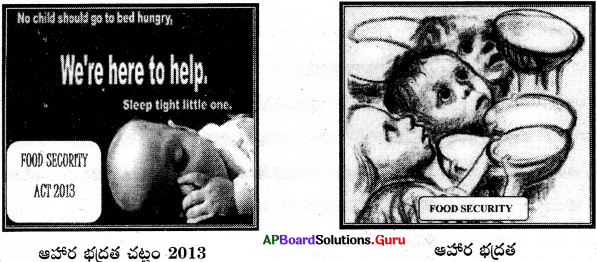
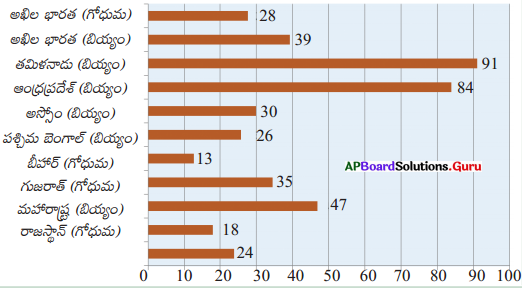
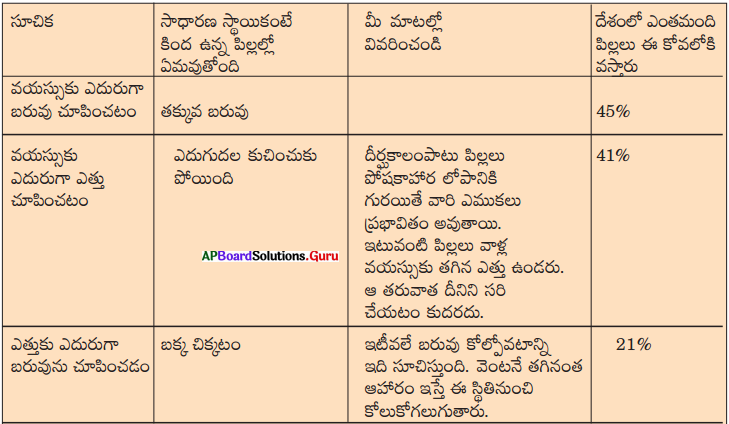
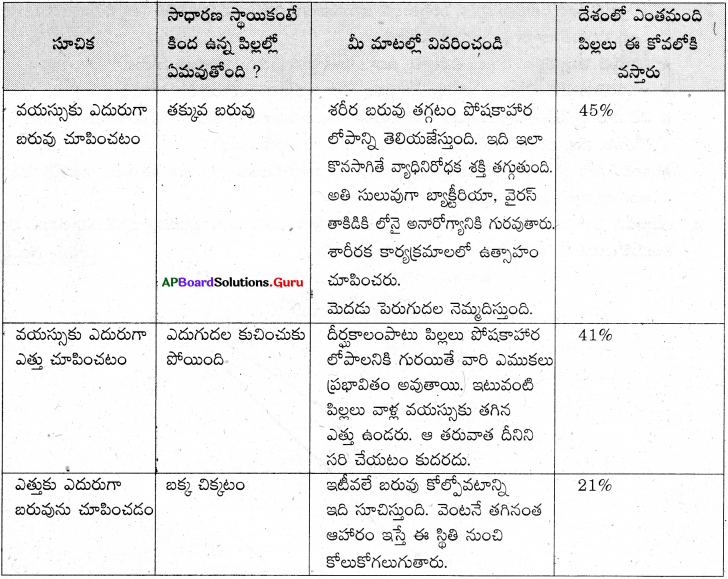
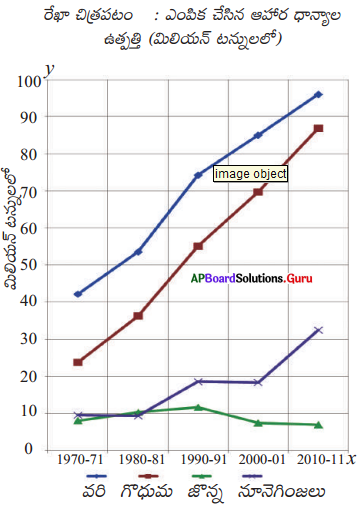
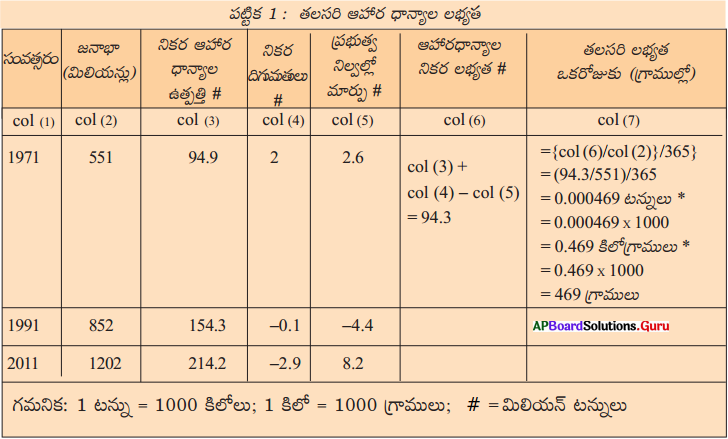
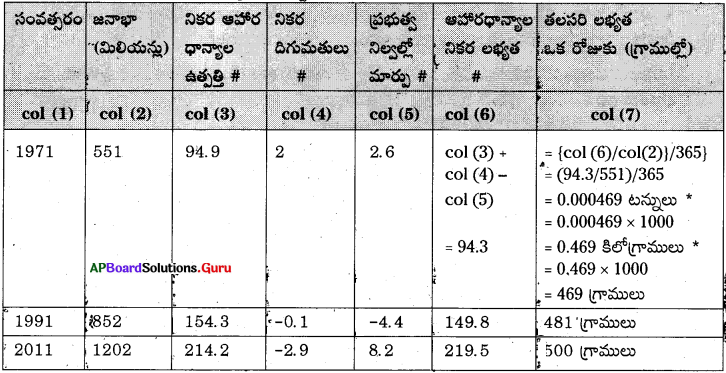
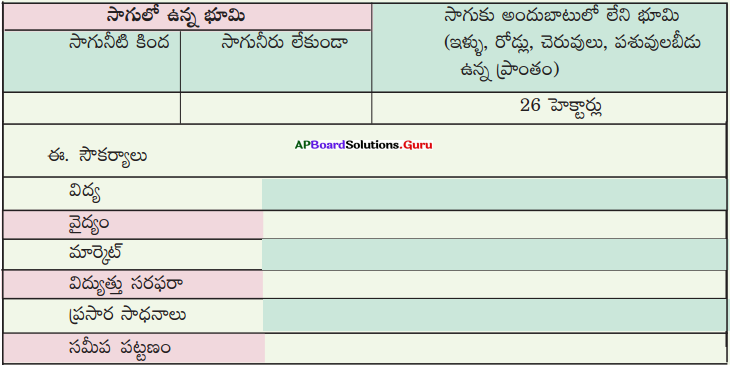
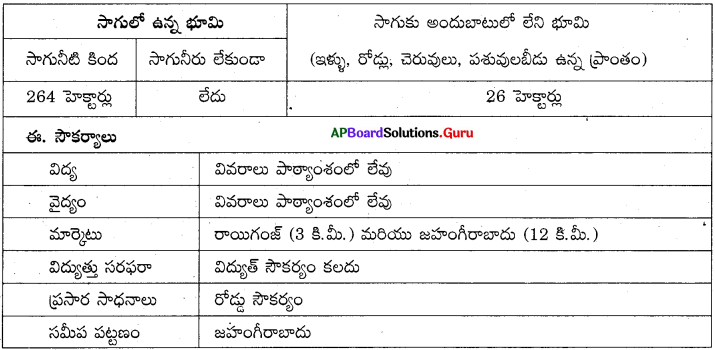
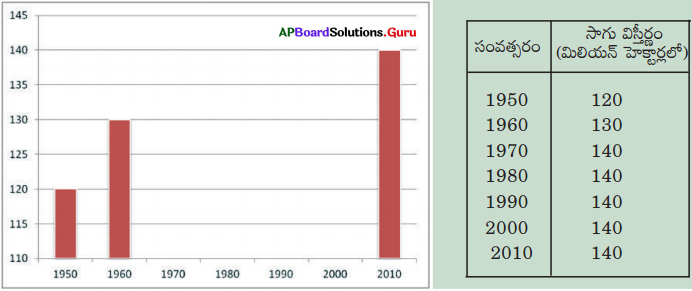
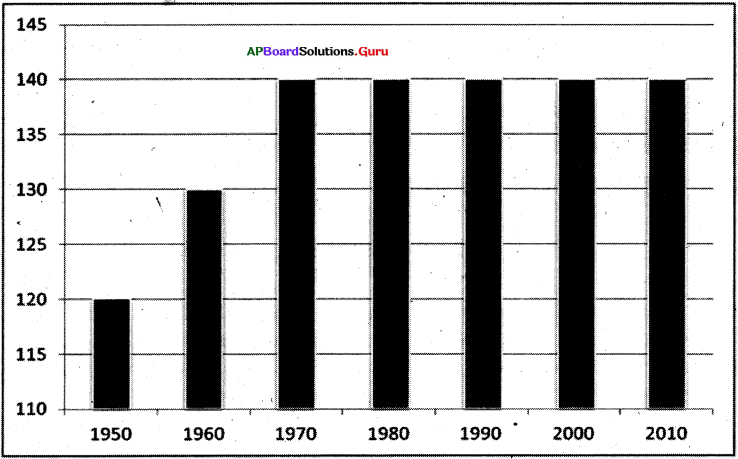


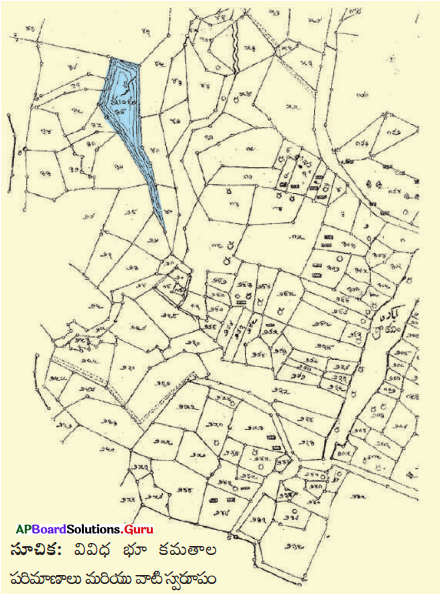

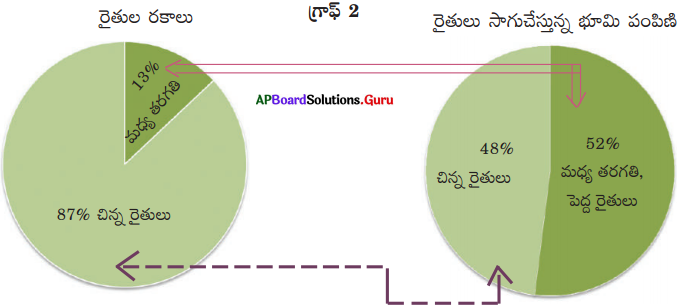

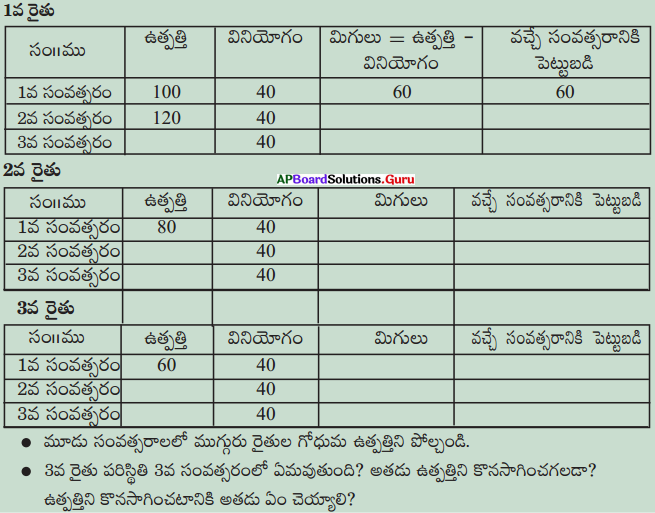

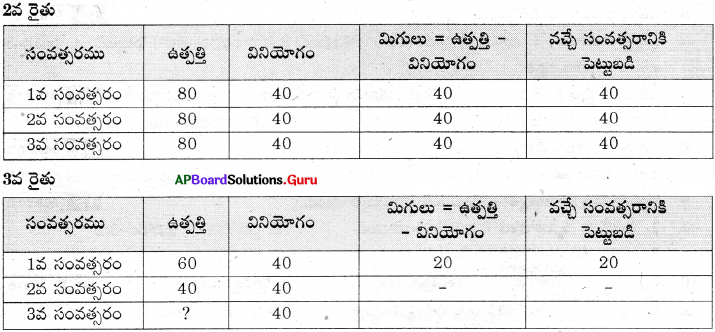
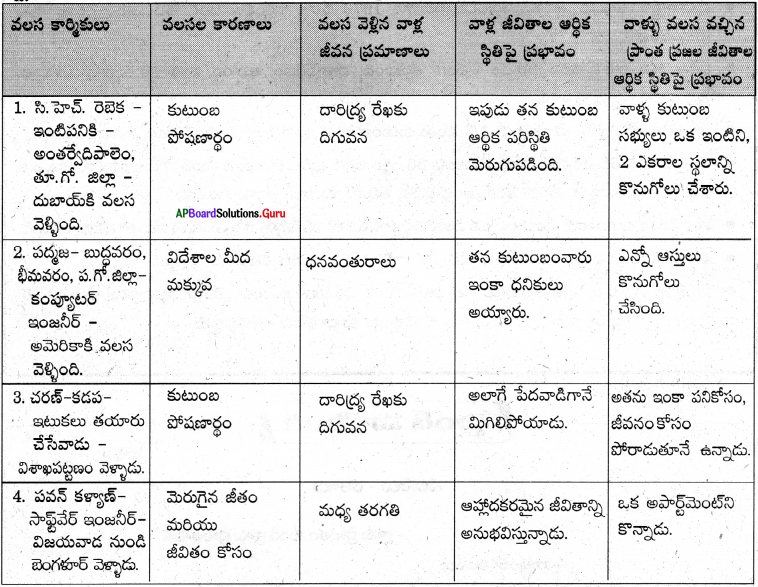
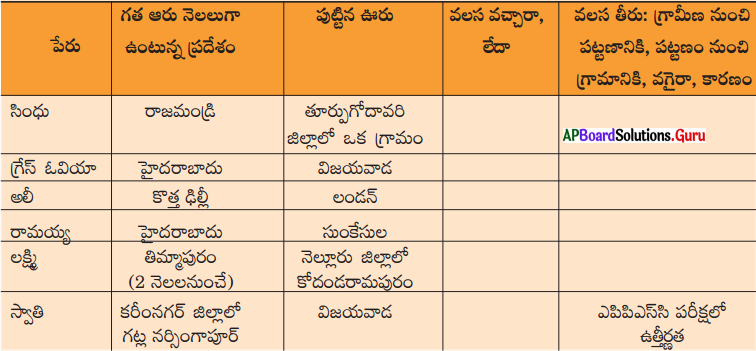
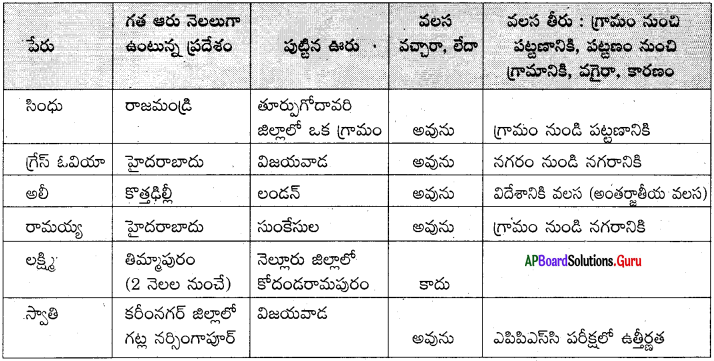
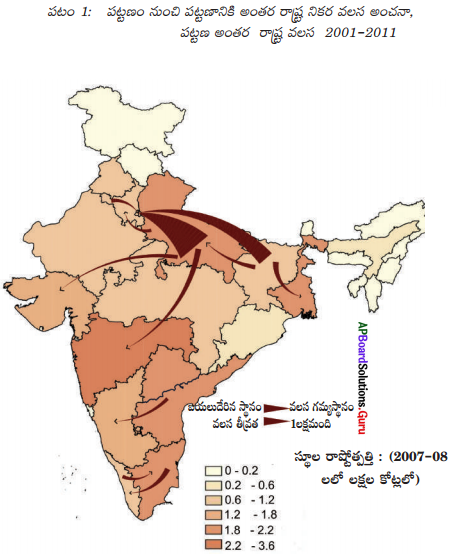
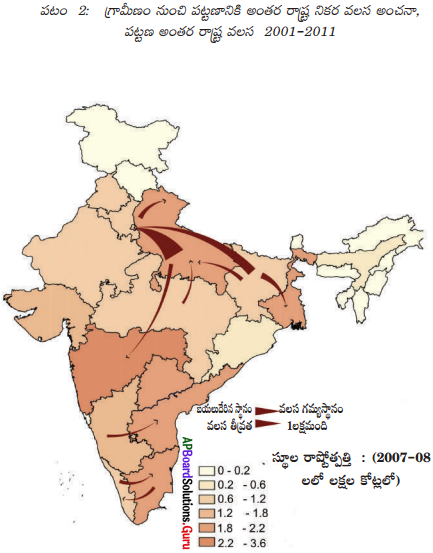
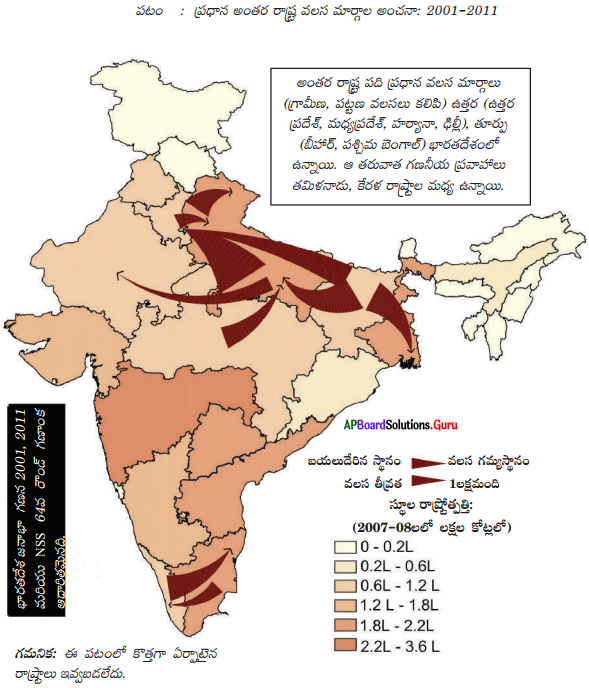

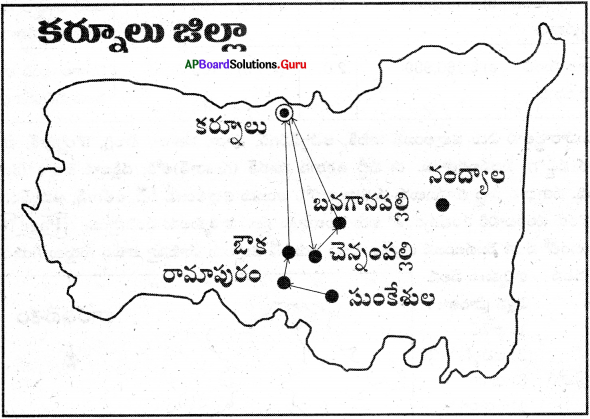
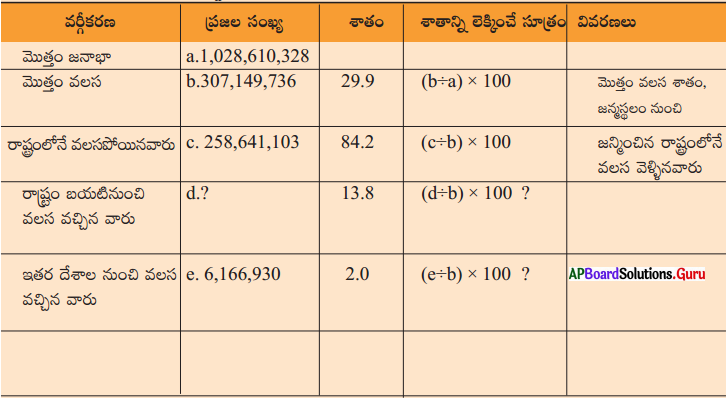
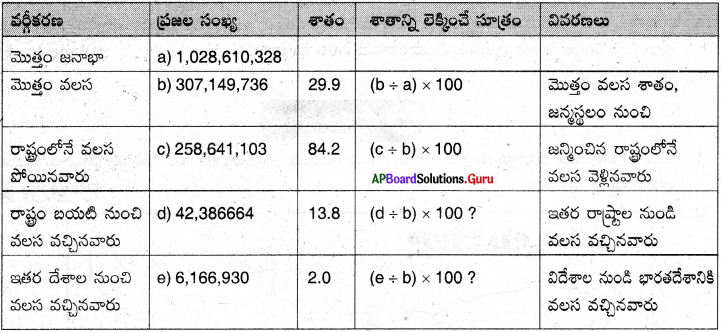
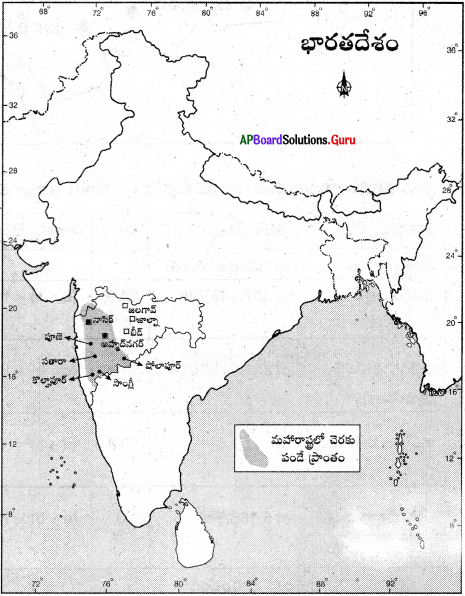
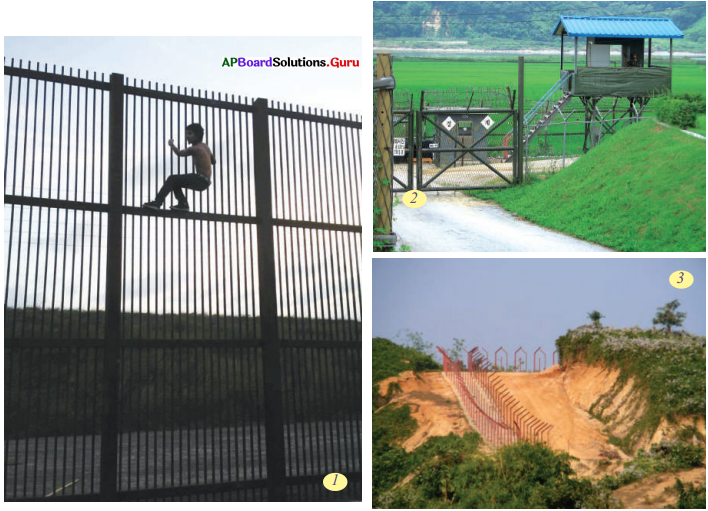
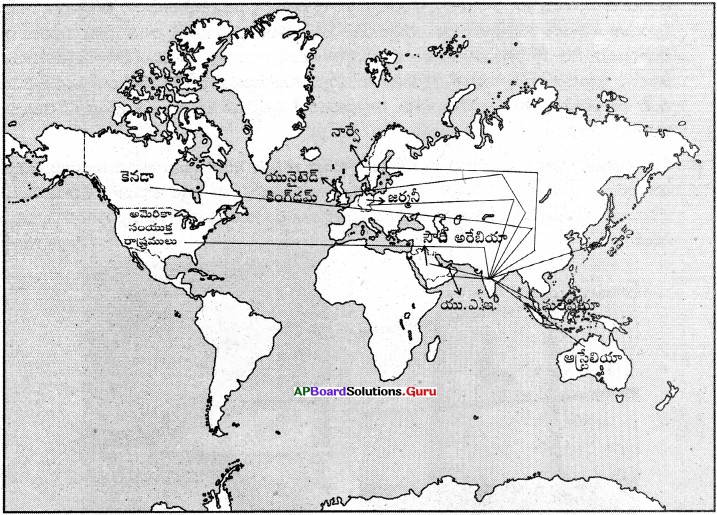



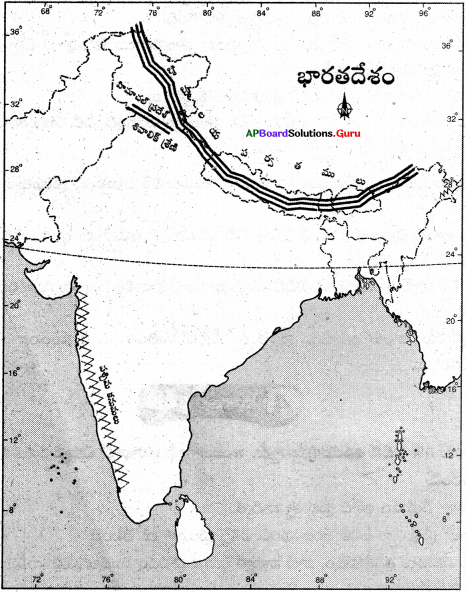
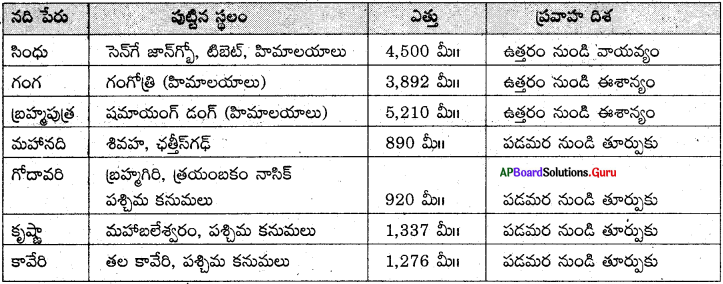
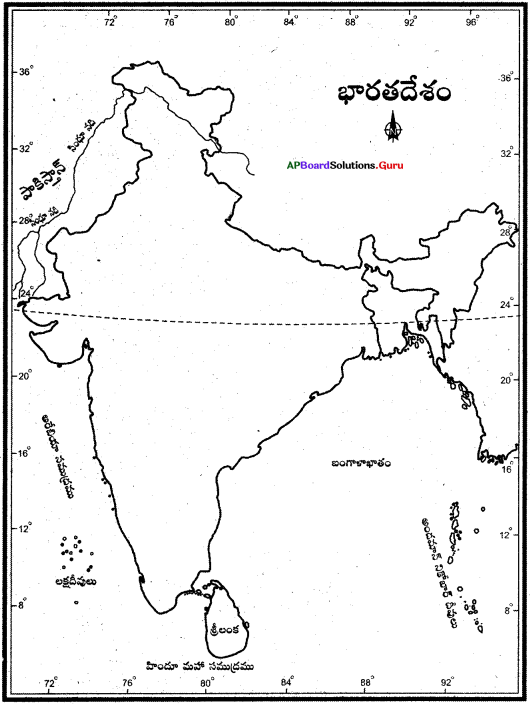
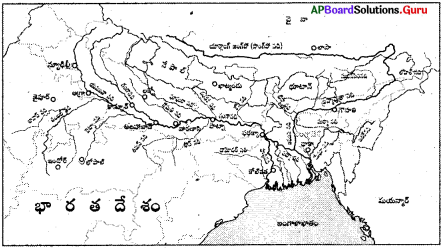
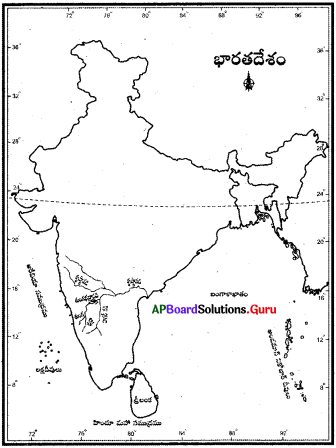
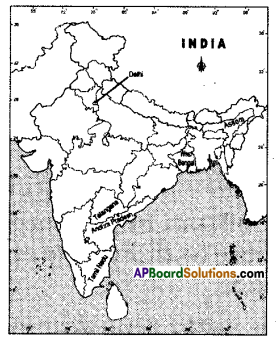

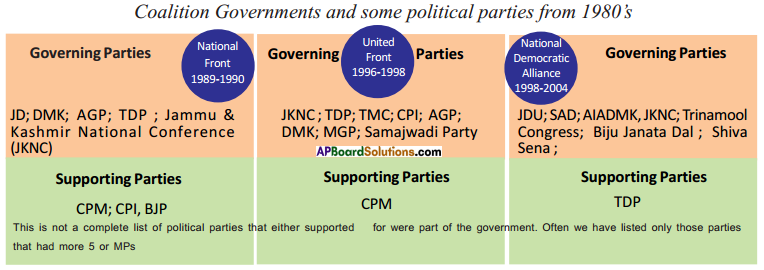

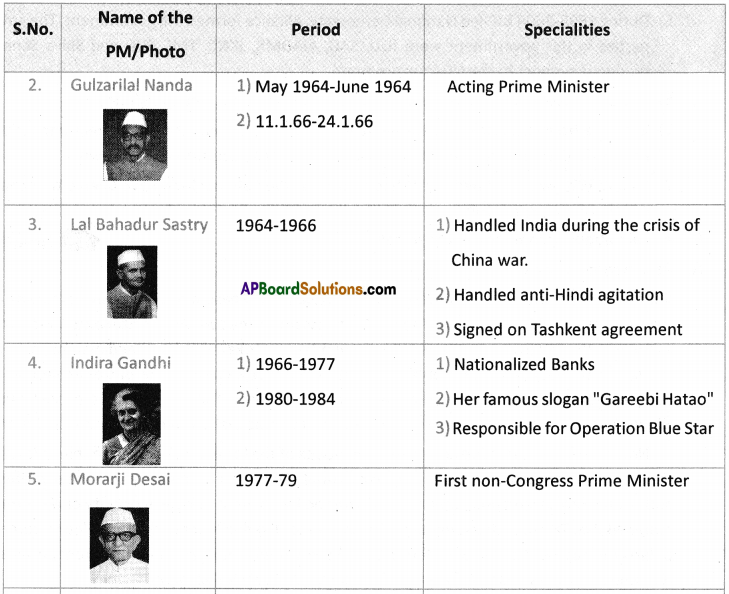
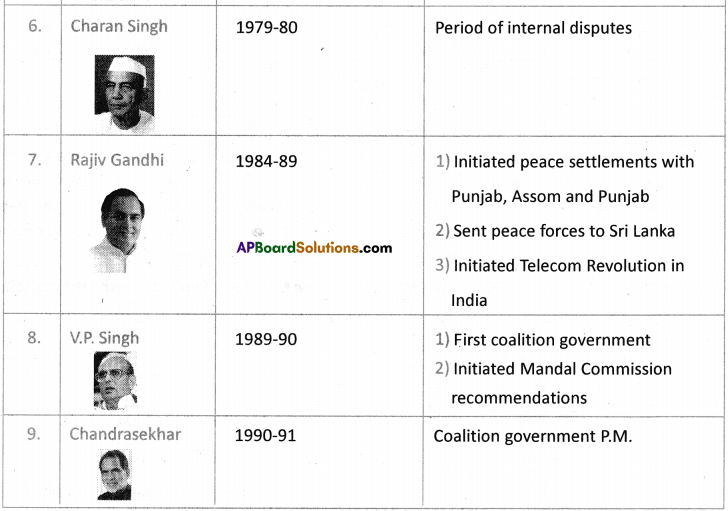
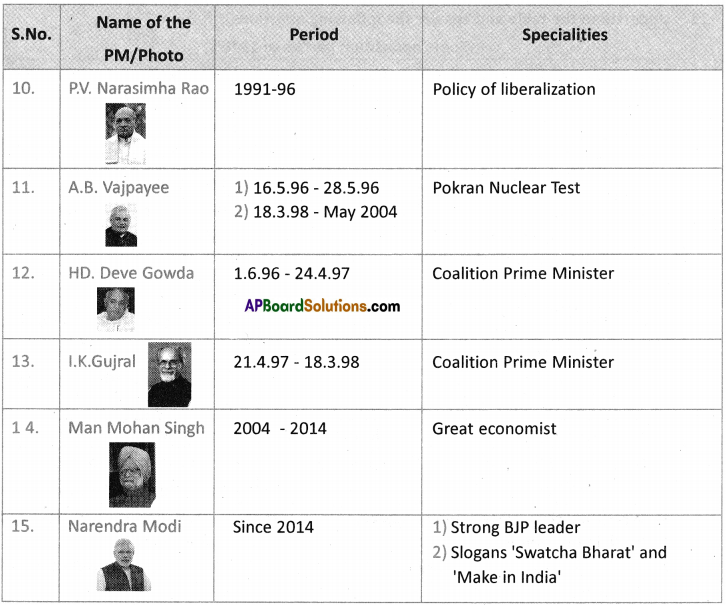
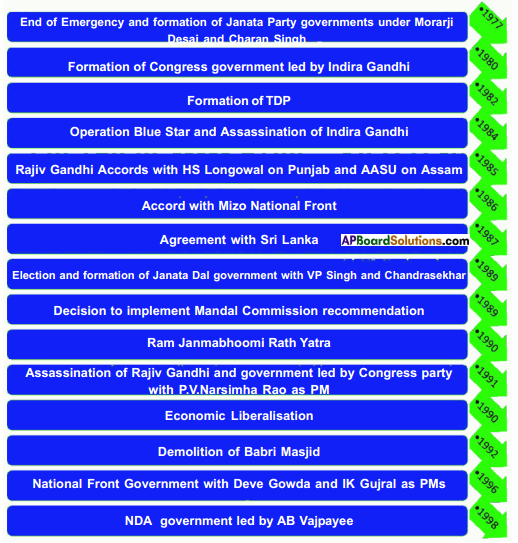 a) Who was the Prime Minister that initiated peace agreements with Sri Lanka?
a) Who was the Prime Minister that initiated peace agreements with Sri Lanka?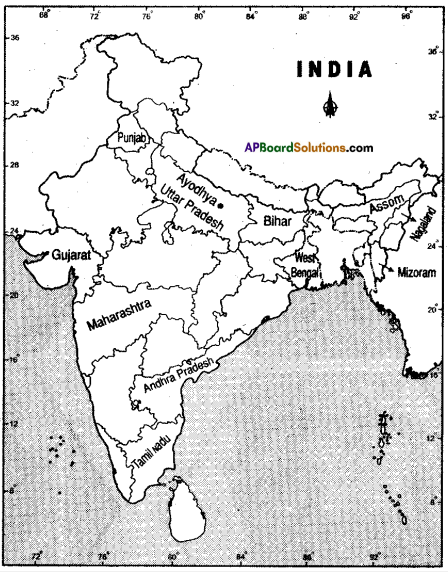
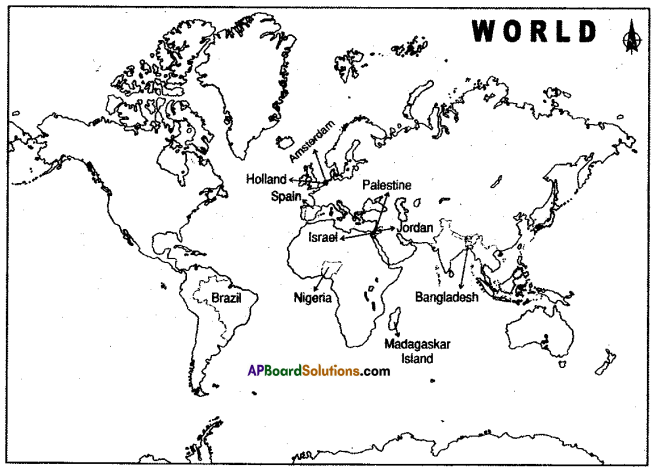
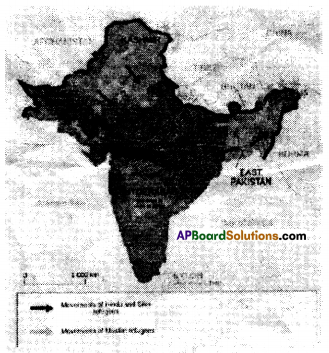 Answer:
Answer: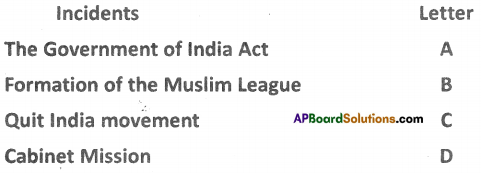 Write the suitable ENGLISH LETTER for each event listed above in the boxes against each on the timeline.
Write the suitable ENGLISH LETTER for each event listed above in the boxes against each on the timeline.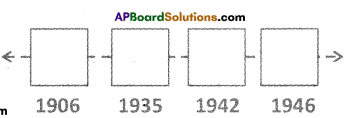

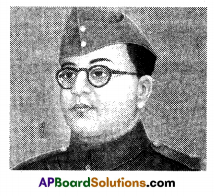
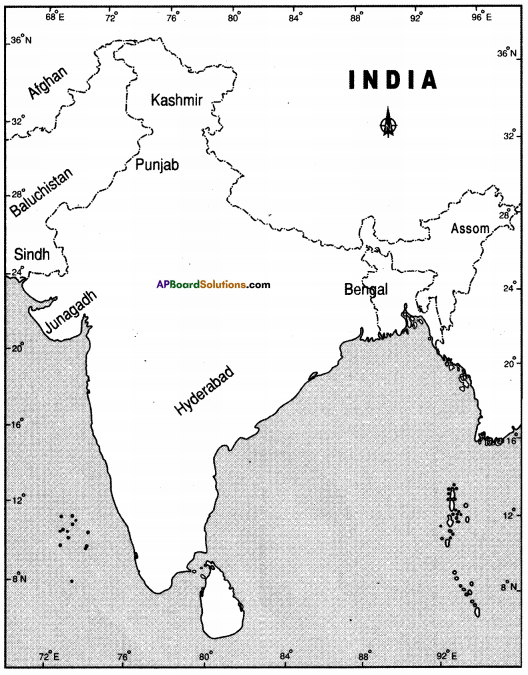

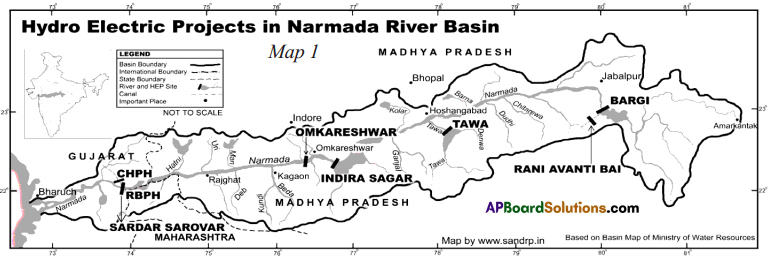 In which state, Indira Sagar Project is located and on which river?
In which state, Indira Sagar Project is located and on which river?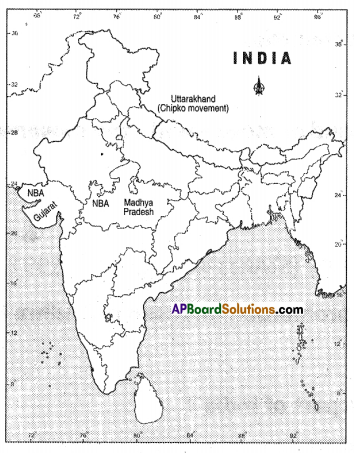
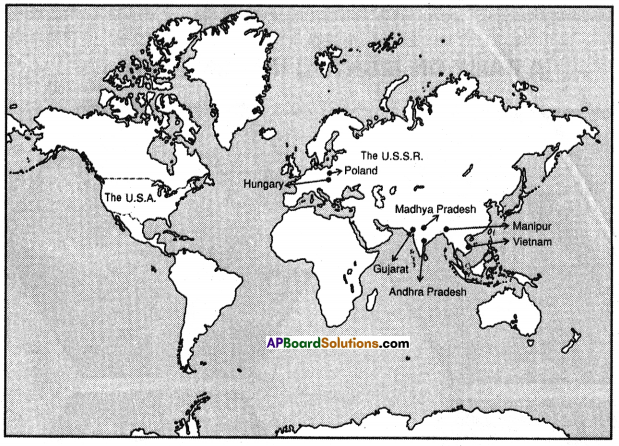
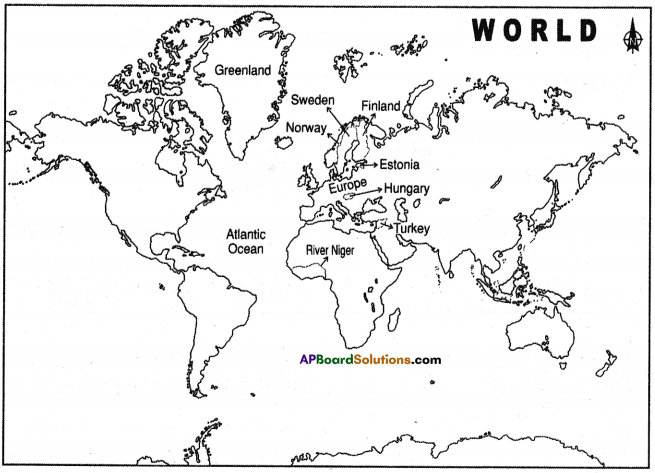
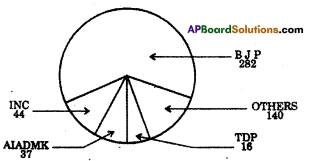 Answer:
Answer: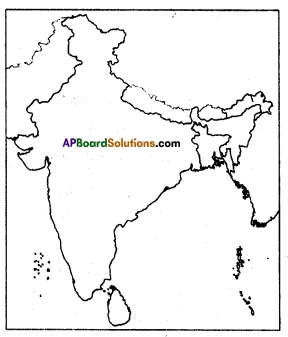
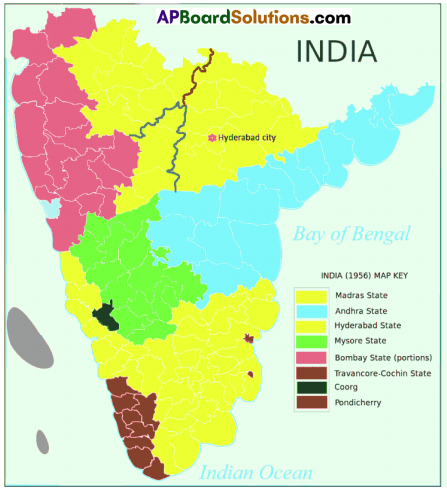
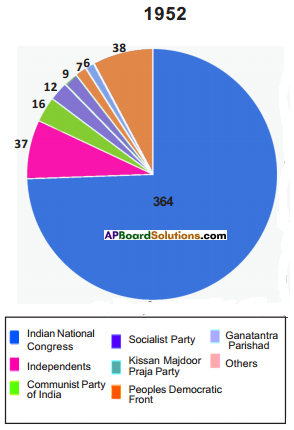 1. Which political party secured less seats ?
1. Which political party secured less seats ?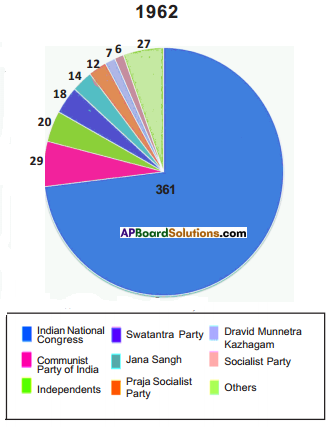
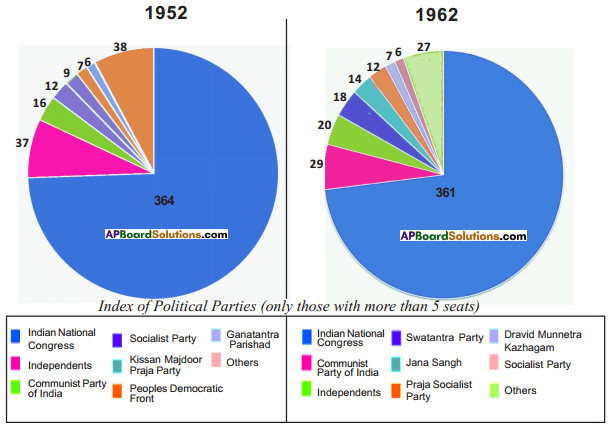 Compare the above Pie diagrams.
Compare the above Pie diagrams.